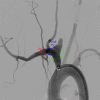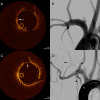Acute thrombus formation on phosphorilcholine surface modified flow diverters
- PMID: 28689183
- PMCID: PMC5869458
- DOI: 10.1136/neurintsurg-2017-013175
Acute thrombus formation on phosphorilcholine surface modified flow diverters
Abstract
Purpose: Thromboembolic complications remain a limitation of flow diverting stents. We hypothesize that phosphorilcholine surface modified flow diverters (Pipeline Flex with Shield Technology, sPED) would have less acute thrombus formation on the device surface compared with the classic Pipeline Embolization device (cPED).
Methods: Elastase-induced aneurysms were created in 40 rabbits and randomly assigned to receive cPED or sPED devices with and without dual antiplatelet therapy (DAPT) (four groups, n=10/group). Angioplasty was performed to enhance apposition and create intimal injury for a pro-thrombotic environment. Both before and after angioplasty, the flow diverter was imaged with intravascular optical coherence tomography. The outcome measure was the number of predefined segments along the implant relative to the location of the aneurysm with a minimum of 0 (no clot formation) and maximum of 3 (all segments with thrombus). Clot formation over the device at ostia of branch arteries was assessed as either present or absent.
Results: Following angioplasty, the number of flow diverter segments with clots was significantly associated with the flow diverter (p<0.0001), but not with DAPT (p=0.3872) or aneurysm neck size (p=0.8555). The incidence rate for clots with cPED was 1.72 times more than with sPED. The clots on the flow diverter at the location corresponding to side branch ostia was significantly lower with sPED than with cPED (OR 0.180; 95% CI 0.044 to 0.734; p=0.0168), but was not associated with DAPT (p=0.3198).
Conclusion: In the rabbit model, phosphorilcholine surface modified flow diverters are associated with less thrombus formation on the surface of the device.
Keywords: dual antiplatelet therapy; flow diverters; intracranial aneurysms; optical coherence tomography.
© Article author(s) (or their employer(s) unless otherwise stated in the text of the article) 2018. All rights reserved. No commercial use is permitted unless otherwise expressly granted.
Conflict of interest statement
Competing interests: MM, FC, ETL, RMK, OWB, TT, SV: None. JMW: Employed by Medtronic Neurovascular. MJG: Has been a consultant on a fee-per-hour basis for Codman Neurovascular, InNeuroCo and Stryker Neurovascular; holds stock in InNeuroCo; and has received research support from the National Institutes of Health (NIH), CereVasc LLC, Codman Neurovascular, Gentuity, Microvention, Medtronic Neurovascular, Neuravi, Philips Healthcare, InNeuroCo, Rapid Medical, Stryker Neurovascular, and the Wyss Institute. ASP: Has been a consultant on a fee-per-hour basis for Medtronic Neurovascular and Stryker Neurovascular; and has received research grants from Medtronic Neurovascular and Stryker Neurovascular.
Figures



Similar articles
-
Phosphorylcholine surface modified flow diverter associated with reduced intimal hyperplasia.J Neurointerv Surg. 2018 Nov;10(11):1097-1101. doi: 10.1136/neurintsurg-2018-013776. Epub 2018 Mar 6. J Neurointerv Surg. 2018. PMID: 29511117
-
Preliminary outcomes of single antiplatelet therapy for surface-modified flow diverters in an animal model: analysis of neointimal development and thrombus formation using OCT.J Neurointerv Surg. 2019 Jan;11(1):74-79. doi: 10.1136/neurintsurg-2018-013935. Epub 2018 May 26. J Neurointerv Surg. 2019. PMID: 29804090 Free PMC article.
-
Communicating malapposition of flow diverters assessed with optical coherence tomography correlates with delayed aneurysm occlusion.J Neurointerv Surg. 2018 Jul;10(7):693-697. doi: 10.1136/neurintsurg-2017-013502. Epub 2017 Nov 10. J Neurointerv Surg. 2018. PMID: 29127197
-
Periprocedural complications of second-generation flow diverter treatment using Pipeline Flex for unruptured intracranial aneurysms: a systematic review and meta-analysis.J Neurointerv Surg. 2019 Aug;11(8):817-824. doi: 10.1136/neurintsurg-2019-014937. Epub 2019 May 30. J Neurointerv Surg. 2019. PMID: 31147438
-
New therapies for unruptured intracranial aneurysms.Neurol Clin. 2013 Aug;31(3):737-47. doi: 10.1016/j.ncl.2013.03.011. Epub 2013 May 17. Neurol Clin. 2013. PMID: 23896502 Review.
Cited by
-
Biomimetic materials based on zwitterionic polymers toward human-friendly medical devices.Sci Technol Adv Mater. 2022 Sep 13;23(1):498-524. doi: 10.1080/14686996.2022.2119883. eCollection 2022. Sci Technol Adv Mater. 2022. PMID: 36117516 Free PMC article. Review.
-
Ruptured Fusiform Aneurysm of the Anterior Spinal Artery : Successful Treatment with Flow Diverter Stent Placed in the Feeding Vertebral Artery.Clin Neuroradiol. 2018 Dec;28(4):613-616. doi: 10.1007/s00062-018-0684-2. Epub 2018 Apr 12. Clin Neuroradiol. 2018. PMID: 29651585 Review. No abstract available.
-
Optimal duration of dual antiplatelet therapy for stent-assisted coiling or flow diverter placement.J Neurointerv Surg. 2024 Apr 23;16(5):491-497. doi: 10.1136/jnis-2023-020285. J Neurointerv Surg. 2024. PMID: 37344176 Free PMC article.
-
Pipeline shield with single antiplatelet therapy in aneurysmal subarachnoid haemorrhage: multicentre experience.J Neurointerv Surg. 2019 Jul;11(7):694-698. doi: 10.1136/neurintsurg-2018-014363. Epub 2018 Dec 14. J Neurointerv Surg. 2019. PMID: 30552166 Free PMC article.
-
PED Flex with Shield Technology: a feasible alternative for fusiform MCA aneurysms.Stroke Vasc Neurol. 2018 May 26;3(3):185-188. doi: 10.1136/svn-2017-000132. eCollection 2018 Sep. Stroke Vasc Neurol. 2018. PMID: 30294475 Free PMC article. No abstract available.
References
-
- Becske T, Brinjikji W, Potts MB, et al. . Long-Term clinical and angiographic outcomes following pipeline embolization device treatment of complex internal carotid artery aneurysms: five-year results of the pipeline for uncoilable or failed aneurysms trial. Neurosurgery 2017;80:40–8. 10.1093/neuros/nyw014 - DOI - PubMed
-
- Rodriguez AE, Rodriguez Alemparte M, Fernandez Pereira C, et al. . Latin American randomized trial of balloon angioplasty versus coronary stenting in diabetic patients with small vessel reference size (Latin American small vessel [LASMAL II] Trial): immediate and long-term results. Am Heart J 2005;150:188 10.1016/j.ahj.2005.05.013 - DOI - PubMed
MeSH terms
Substances
LinkOut - more resources
Full Text Sources
Other Literature Sources
Medical
